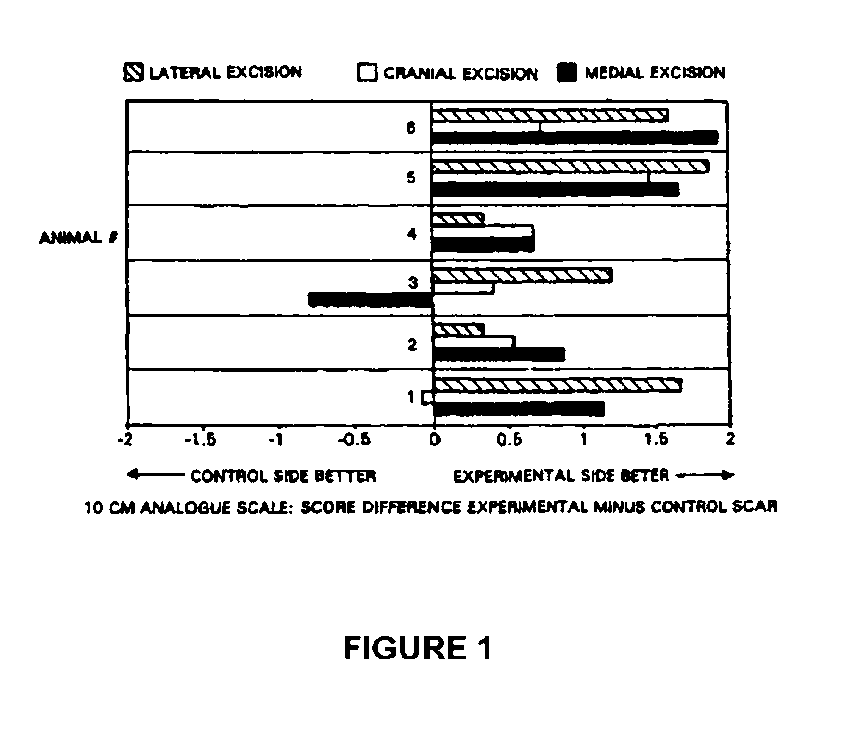Methods for enhancing wound healing
a wound healing and wound technology, applied in the field of wound healing enhancement, can solve the problems of increasing skin tension and affecting wound healing, affecting wound healing, and etiology of skin tension lines, and achieves the effects of reducing scar formation, reducing skin tension, and reducing scar formation
- Summary
- Abstract
- Description
- Claims
- Application Information
AI Technical Summary
Benefits of technology
Problems solved by technology
Method used
Image
Examples
example 1
Would Healing by Injection of a Chemodenervating Agen in Monkeys
[0029] In order to closely mimic the effects of muscle activity on human facial skin wounds, the use of an appropriate animal model was mandatory. Due to extensive skin laxity and inadequate mimetic musculature, established models like rats, pigs, and horses, were not ideal for this purpose. Cynomolgus macaque monkeys (Macaca fascicularis) were chosen as a model since the anatomy of their cranio facial and cutaneous anatomy resembles that of humans.
[0030] The study was approved by the Institutional Committee of Animal Care and Use at the Mayo Clinic and the animals were housed, cared for, and fed in compliance with the institutional guidelines. No animal was sacrificed. All procedures were performed with anesthesia consisting of Ketamine at 20 mg / kg IM (Ketaset.RTM., Fort Dodge), Xylazine at 0.5 mg / kg IM (Rompun.RTM., Bayer), and Isoflurane at 1% (Isoflurane.RTM., Abbott).
[0031] The forehead was chosen for the excision ...
example 2
Wound Healing by Botulinum Toxin A Injection in Humans
[0041] A male patient (26 years of age, 82 kg) underwent scar revision excision surgery. The scar was located on the forehead approximately 2 cm lateral of the midline on the left, and approximately 3 cm cranial to the most superior extension of the orbital rim. Its direction was horizontal, giving it a favorable position relative to the wrinkle lines. The scar was a result of a trauma at age seven, and was closed at a tertiary referral center at the time.
[0042] The patient was placed in a supine position, and 5 ml of 0.5% lidocaine with 1:200,000 epinephrine was locally injected. The scar was excised and bleeding was controlled with monopolar cautery. Botulinum toxin A was injected (10 units) into the frontalis muscle under direct vision fanning out from the wound. The wound was closed using 6-0 Vicryl for deep and 6-0 Nylon for superficial sutures. An additional 7.5 units of botulinum toxin A were injected into the procerus and...
example 3
n of Scars from Patients Injected with a Chemodenervating Agent Alone or in Combination with a Local Anesthetic
[0044] Healthy volunteers were informed about potential risks and side effects of the treatment. Formal written informed consent was obtained in accordance with the Mayo Institutional Review Board regulations. Prior to enrollment in the study, symmetry of frontalis, procerus, and corrugator supercilii function was assessed and subjects were only included in the study if there was no functional asymmetry present. The forehead of the subjects was divided by the midline into two symmetric sides, one serving as the control and the other as the experiment side. The side of the forehead which was to serve as control was determined randomly, and was injected with Botulinum Toxin A (Botox) reconstituted in 0.9% saline. The experimental side was injected with Botulinum Toxin A reconstituted in 1% or 2% lidocaine with 1:100,000 epinephrine. The combination of these agents with Botuli...
PUM
| Property | Measurement | Unit |
|---|---|---|
| thick | aaaaa | aaaaa |
| diameter | aaaaa | aaaaa |
| muscle tension | aaaaa | aaaaa |
Abstract
Description
Claims
Application Information
 Login to View More
Login to View More - R&D
- Intellectual Property
- Life Sciences
- Materials
- Tech Scout
- Unparalleled Data Quality
- Higher Quality Content
- 60% Fewer Hallucinations
Browse by: Latest US Patents, China's latest patents, Technical Efficacy Thesaurus, Application Domain, Technology Topic, Popular Technical Reports.
© 2025 PatSnap. All rights reserved.Legal|Privacy policy|Modern Slavery Act Transparency Statement|Sitemap|About US| Contact US: help@patsnap.com

